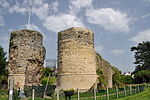Broome Heath Pit
Geological Conservation Review sitesSites of Special Scientific Interest in Norfolk

Broome Heath Pit is a 1.2-hectare (3.0-acre) geological Site of Special Scientific Interest east of Ditchingham in Norfolk. It is a Geological Conservation Review site and part of Broome Heath Local Nature ReserveThis site exposes rocks dating to the Wolstonian glaciation between around 350,000 and 130,000 years ago. It provides the only surviving exposure of the Broome Terrace, the flood plain of an ancient river. Ice wedges and fossils of Arctic flora and fauna indicate a tundra environment.The site is open to the public but much of it is covered with dense scrub.
Excerpt from the Wikipedia article Broome Heath Pit (License: CC BY-SA 3.0, Authors, Images).Broome Heath Pit
Loddon Road, South Norfolk Ditchingham
Geographical coordinates (GPS) Address Nearby Places Show on map
Geographical coordinates (GPS)
| Latitude | Longitude |
|---|---|
| N 52.473 ° | E 1.454 ° |
Address
Loddon Road
Loddon Road
NR35 2RF South Norfolk, Ditchingham
England, United Kingdom
Open on Google Maps









